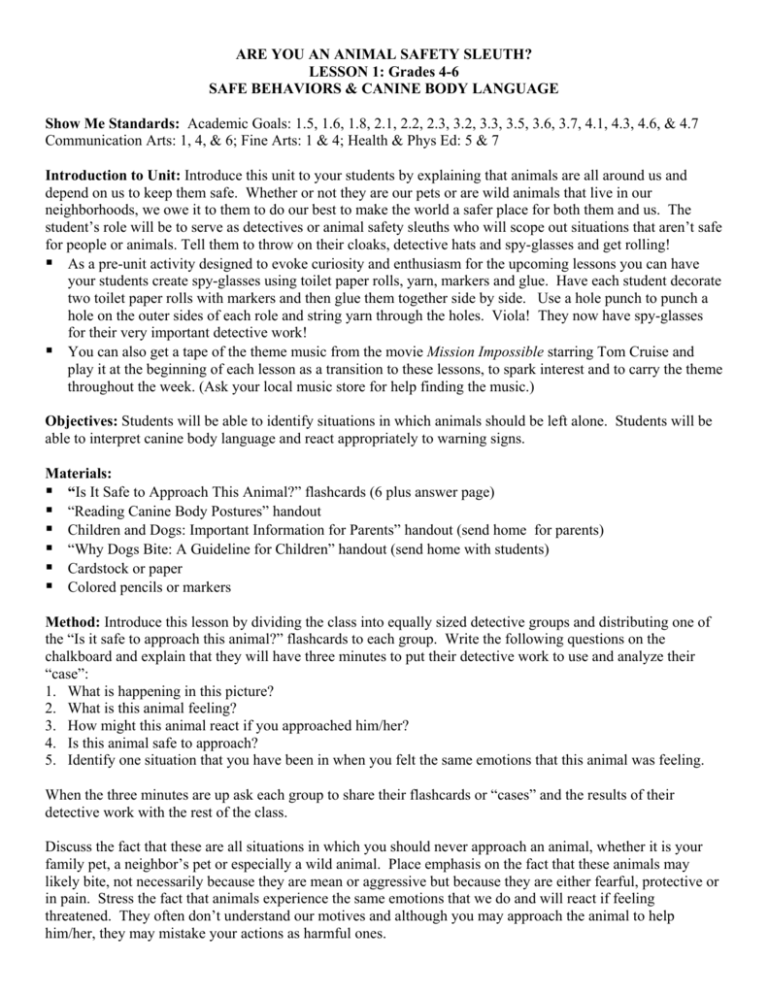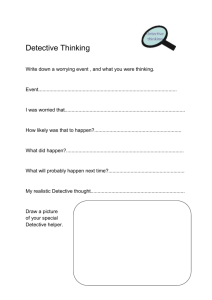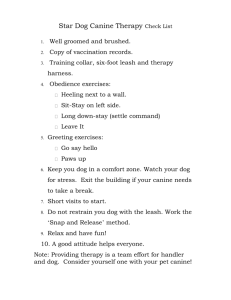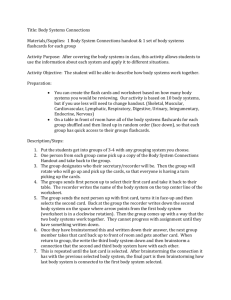LESSON 1 - Humane Society of Missouri
advertisement

ARE YOU AN ANIMAL SAFETY SLEUTH? LESSON 1: Grades 4-6 SAFE BEHAVIORS & CANINE BODY LANGUAGE Show Me Standards: Academic Goals: 1.5, 1.6, 1.8, 2.1, 2.2, 2.3, 3.2, 3.3, 3.5, 3.6, 3.7, 4.1, 4.3, 4.6, & 4.7 Communication Arts: 1, 4, & 6; Fine Arts: 1 & 4; Health & Phys Ed: 5 & 7 Introduction to Unit: Introduce this unit to your students by explaining that animals are all around us and depend on us to keep them safe. Whether or not they are our pets or are wild animals that live in our neighborhoods, we owe it to them to do our best to make the world a safer place for both them and us. The student’s role will be to serve as detectives or animal safety sleuths who will scope out situations that aren’t safe for people or animals. Tell them to throw on their cloaks, detective hats and spy-glasses and get rolling! As a pre-unit activity designed to evoke curiosity and enthusiasm for the upcoming lessons you can have your students create spy-glasses using toilet paper rolls, yarn, markers and glue. Have each student decorate two toilet paper rolls with markers and then glue them together side by side. Use a hole punch to punch a hole on the outer sides of each role and string yarn through the holes. Viola! They now have spy-glasses for their very important detective work! You can also get a tape of the theme music from the movie Mission Impossible starring Tom Cruise and play it at the beginning of each lesson as a transition to these lessons, to spark interest and to carry the theme throughout the week. (Ask your local music store for help finding the music.) Objectives: Students will be able to identify situations in which animals should be left alone. Students will be able to interpret canine body language and react appropriately to warning signs. Materials: “Is It Safe to Approach This Animal?” flashcards (6 plus answer page) “Reading Canine Body Postures” handout Children and Dogs: Important Information for Parents” handout (send home for parents) “Why Dogs Bite: A Guideline for Children” handout (send home with students) Cardstock or paper Colored pencils or markers Method: Introduce this lesson by dividing the class into equally sized detective groups and distributing one of the “Is it safe to approach this animal?” flashcards to each group. Write the following questions on the chalkboard and explain that they will have three minutes to put their detective work to use and analyze their “case”: 1. What is happening in this picture? 2. What is this animal feeling? 3. How might this animal react if you approached him/her? 4. Is this animal safe to approach? 5. Identify one situation that you have been in when you felt the same emotions that this animal was feeling. When the three minutes are up ask each group to share their flashcards or “cases” and the results of their detective work with the rest of the class. Discuss the fact that these are all situations in which you should never approach an animal, whether it is your family pet, a neighbor’s pet or especially a wild animal. Place emphasis on the fact that these animals may likely bite, not necessarily because they are mean or aggressive but because they are either fearful, protective or in pain. Stress the fact that animals experience the same emotions that we do and will react if feeling threatened. They often don’t understand our motives and although you may approach the animal to help him/her, they may mistake your actions as harmful ones. Tell the students that animals often show signs that they are uneasy, scared, or angry by using body language just like we do. Say you are going to have them demonstrate this. Ask for four volunteers to come up to the front of the class one at a time to act out an emotion that you whisper in their ear (sad, angry, scared and in pain). Once the students have identified the emotions correctly, pass out the handout titled “Reading Canine Body postures” and read and discuss the diagrams and vocabulary (submission, aggressive, neutral, passive, active and defensive). Explain that the only dog that is approachable in these diagrams is the dog in the neutral relaxed position but should only be approached if the owner is present and permission has been granted. *Reminder: This is a good time to review what to do if approached by a strange dog and how to meet a dog who is with it’s owner. Please refer to the lessons 4 & 5 for grades K-3 titled Stranger Danger and How to Meet a Dog. If an animal is injured or needs help, get an adult or call your local animal welfare organization (humane society, animal control, wildlife organization). These numbers can be found in the yellow pages, which they will research for a later lesson. (See the handout titled “important numbers” in lesson 4.) Call to Action: Explain that the detectives are now going to put their knowledge to work by making flip-up cards for younger students in the school. Display the “Is it safe to approach this animal” flashcards in the room so they can be seen by all the students and serve as a reference while creating their flip-up cards. Each group will create a flip-up card for each flashcard (“case”). Have the students get into their original detective groups and give them several sheets of white paper. Instruct them to fold each paper in half with the crease/fold at the top of the paper so that it will flip open like a calendar. With the paper folded over like this they are to re-create one of the pictures by drawing it on top of the folded card. They are then to flip open the card and write a few short sentences about the case and why you should leave this animal alone. Have them write in pencil so they/you can edit their writing. For example: Draw a picture of the Momma cat with her babies on the top of the folded flip-up card and then open the card and write something like: This Momma cat is with her babies. Leave her alone. She may think you are going to hurt her babies and might try to bite you. Have each group make a complete set of these flip-up cards and arrange a visit to a classroom with younger groups of students so your detectives can share their work and teach others in your school to be safe around animals too! Attention Teachers: See the following activity sheet “Pet Safety Jumble” Related Reading: Please send these handouts home with your students: -“Children and Dogs: Important Information for Parents” handout -“Why Dogs Bite: A Guideline for Children” handout Web sites: Visit our section entitled Recommended Web Links for animal-related web sites.





